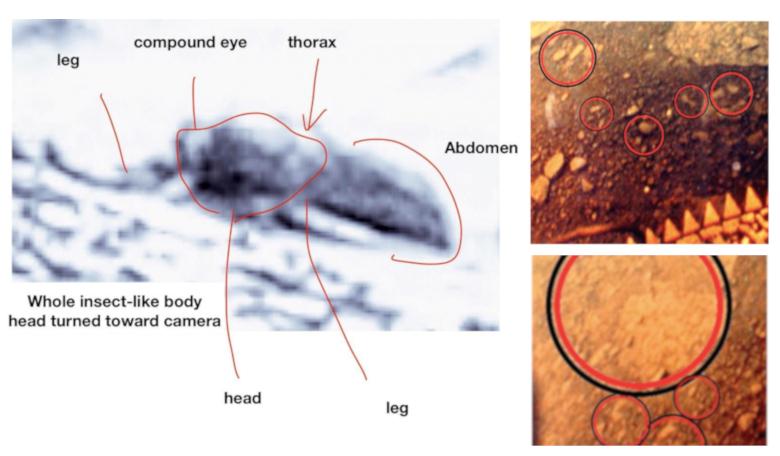Are our nearest planetary neighbours really that inhabitable that no life could have taken hold in the ~4.5 billion years since the birth of the Solar System? Not necessarily so, say two scientists working on two separate studies, who in the last week have presented research in favour of extant (and extinct) biological life forms on Mars and fungi on Venus.
Yesterday at the national meeting of the Entomological Society of America, in St. Louis, Missouri, Ohio University Professor Emeritus William Romoser's showed images which he specified clearly shows that evidence for numerous examples of insect/arthropod-like forms, both as fossils and living creatures can be distinguished in photographs taken by various Mars rovers.
Romoser, who specialises in arbovirology and general/medical entomology, has spent several years studying photographs from Mars that are available to the public on the Internet.
"There has been and still is life on Mars," Romoser said at the meeting. "There is apparent diversity among the Martian insect-like fauna which display many features similar to Terran insects that are interpreted as advanced groups—for example, the presence of wings, wing flexion, agile gliding/flight, and variously structured leg elements."
Evidence of a fossil reptile-like (serpentine) form and reptile-like forms preying on insect-like forms was also presented by the Professor in his work entitled; “Does insect/arthropod biodiversity extend beyond earth?”
Numerous photos displayed by Romoser showed images where arthropod body segments, antennae, legs and wings can be picked out from the surrounding area.
"Once a clear image of a given form was identified and described, it was useful in facilitating recognition of other less clear, but none-the-less valid, images of the same basic form," Romoser said. "An exoskeleton and jointed appendages are sufficient to establish identification as an arthropod. Three body regions, a single pair of antennae, and six legs are traditionally sufficient to establish identification as 'insect' on Earth. These characteristics should likewise be valid to identify an organism on Mars as insect-like. On these bases, arthropodan, insect-like forms can be seen in the Mars rover photos."
Its not just fossilised specimens that Rosomer presented; one even appears to show one of the insects in a steep dive before pulling up just before hitting the ground.
"The presence of higher metazoan organisms on Mars implies the presence of nutrient/energy sources and processes, food chains and webs, and water as elements functioning in a viable, if extreme, ecological setting sufficient to sustain life," he said.
"The evidence of life on Mars presented here provides a strong basis for many additional important biological as well as social and political questions," added Rosomer. “It also represents a solid justification for further study."
Meanwhile, in a different study, Rhawn Joseph at the Astrobiology Associates of Northern California San Francisco, Sant Cruz, has presented evidence for the possibility of life on the subsurface and clouds of Venus in the form of fungal mushroom-shaped organisms that were photographed by the Russian Space Probe Venera 13 in 1982.
There are a number of ways that life might be present on both Mars and Venus says Joseph, but in each case it is via organisms spreading from Earth that has led to these planets being seeded with life.
These include; extremophiles attached to dust particles which are then lofted into Earth’s upper atmosphere and blown to Mars and Venus via powerful solar winds, through microbes hitching a ride on space crafts, or from microbe-packed rocks that have been ejected into space from Earth’s surface following a comet or meteor impact. As Earth rocks have recently been found on the Moon, processes of this nature must have occurred in the past.
Recent research has also indicated that Venus may have had oceans and rivers early in its history and, says Joseph, some of those species which, theoretically, colonised the planet during that time, may have adapted and evolved when those oceans evaporated and temperatures rose.
That life, might now be hiding out within the lower cloud layers of Venus’ atmosphere or underground to a depth of 10 metres where temperature may be as low as 200 ◦C, which is within the tolerance level of some hyperthermophiles (organisms that thrive in extremely hot environments), says Joseph is his recent paper published by the (Nature/Springer) journal, Astrophysics and Space Science.
But tolerant, Venus is not. With a dense, crushing atmosphere - Venus' atmosphere is 90 times more dense than that on Earth – and a scorching mean surface temperature of 465°C, the incredibly hostile environment of Earth's "twin" planet meant that the descent lander of Venera 13 lasted just 127 minutes on the surface before it stopped working.
On its decent however, Joseph states that as the craft landed it blew away surrounding top soil exposing some of the subsurface mushroom-looking specimens. These are what are featured in the photos's Venera 13 took before succumbing to its quick demise.
Joseph, who is an advocate of directed panspermia – a hypothesis which suggests that life on Earth did not originate on our planet, but was transported here from somewhere else in the Universe – says that despite Venus' hostile conditions, the planet might still provide a habitable environment for a variety of hyper-extremophiles which might be continually arriving from Earth.
However, states Joseph, it must be stressed that morphology alone is not proof of life and that similarities with these type of organisms on Earth in extreme environments and comparable specimens on the Red Planet should also be considered as evidence. "That one can only speculate as to the identity of these Venusian mushroom-shaped specimens, they are markedly similar to classic terrestrial mushrooms, and similar to those "Martian mushrooms" I've previously identified on Mars,” he added.
“This supports the possibility that fungi, in general, may be hyper-extremophiles, capable of colonising Mars, Venus, and the harshest of alien environments."











